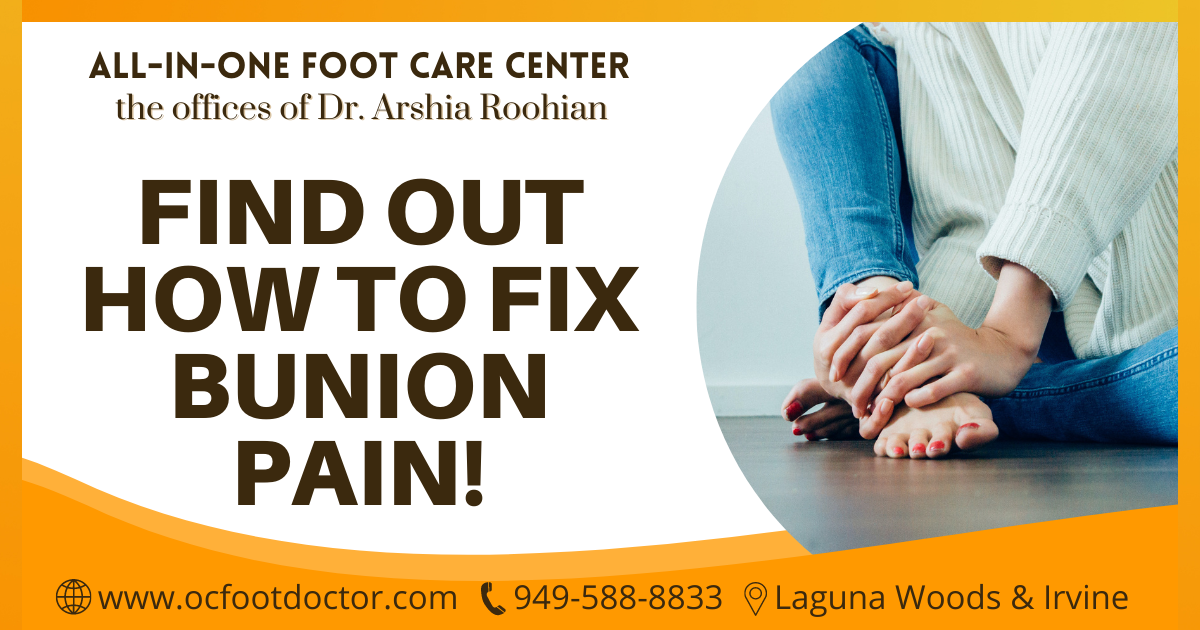Find Out How To Fix Bunion Pain!

Is it painful to have bunions?
If you're one of the 5 million Americans who suffer painful bunions every year, you already know the answer. Absolutely. Foot pain can make it difficult to even go to the refrigerator for a snack, let alone participate in daily activities.
Pain is subjective, however. The severity of a bunion can range from one to ten. You'll need to determine how long you've had the bunion - and what you're planning to do.
The All-In-One Foot Care Center doctors are aware that bunion deformities (also called hallux valgus) are the second most common foot problem in the country, after ankle sprains.
Unfortunately, only about one-third of people with bunions visit a podiatrist. In addition to the painful bunion, the gnarly big toe joint can lead to other issues, including hammertoes.
The majority of bunions occur in women due to wearing ill-fitting shoes and high heels.
Bunion pain: how does it feel?
An inflamed bony bump appears at the base of the big toe when it is a bunion. In the early stages of their formation, there may be little real pain. A little redness, plantar fasciitis, heel pain, a stiff big toe, or difficulty walking in tight-fitting shoes may be observed.
Even though they are simply annoying at the beginning of formation, they are usually not painful at that point. When bunions progress, the area becomes increasingly swollen, red, shiny, and tender to the touch.
Soon, you may develop a callus where the first and second toes rub together as the bunion pushes them together. In this stage of bunion development, you may experience constant burning or intermittent discomfort. When you walk, you may aggravate your knee ligaments.
Consider your life as the bunion becomes more pronounced and begins to cause pain most of the time. You might need to take action if you are unable to do activities that you normally enjoy because of discomfort.
Bunion pain that throbs at night
Bunions can be extremely uncomfortable when walking or wearing tight-fitting shoes. As a result, nerves that are compressed by the bony growth are often inflamed at night, which causes soreness and throbbing.
Phase 1: Treating bunion pain
Your chances of getting relief from over-the-counter bunion pain relievers are slim at best if your swollen bunions cause you considerable pain when you walk.
In any case, you can try several non-surgical treatment options. They include:
- Keep your foot propped up and apply ice to the swollen area
- To prevent your foot from rubbing against your shoe, use bunion pads
- Wearing shoes with wider toe boxes and custom orthotics
- Exercising your foot
- Corticosteroid injections
- Rehabilitation through physical therapy
All or some of these tactics may provide temporary pain relief. Sadly, none of those methods get at the root of the problem.
Phase 2: Long-term pain relief for bunions
Let our board-certified podiatrists examine your problem. Your condition can only be fully assessed by X-rays, and the best way to resolve it can only be determined afterward.
We have foot doctors internationally recognized for their surgical expertise and experience with all types of bunion surgery. In spite of the fact that we are surgeons, we believe surgery should not be taken lightly and should only be considered when other options have failed or are not feasible.
Ready to schedule an appointment? All-in-One Foot Care Center is here to help! You can contact our office at 949-588-8833, or visit our website at https://www.ocfootdoctor.com. Our offices are located in Laguna Hills, Irvine, Mission Viejo, Aliso Viejo, Lake Forest, Foothill Ranch, and Costa Mesa.
📲 949-588-8833
🏢 24331 El Toro Rd, Suite 370 Laguna Woods CA 92637
🌐 https://www.ocfootdoctor.com/


